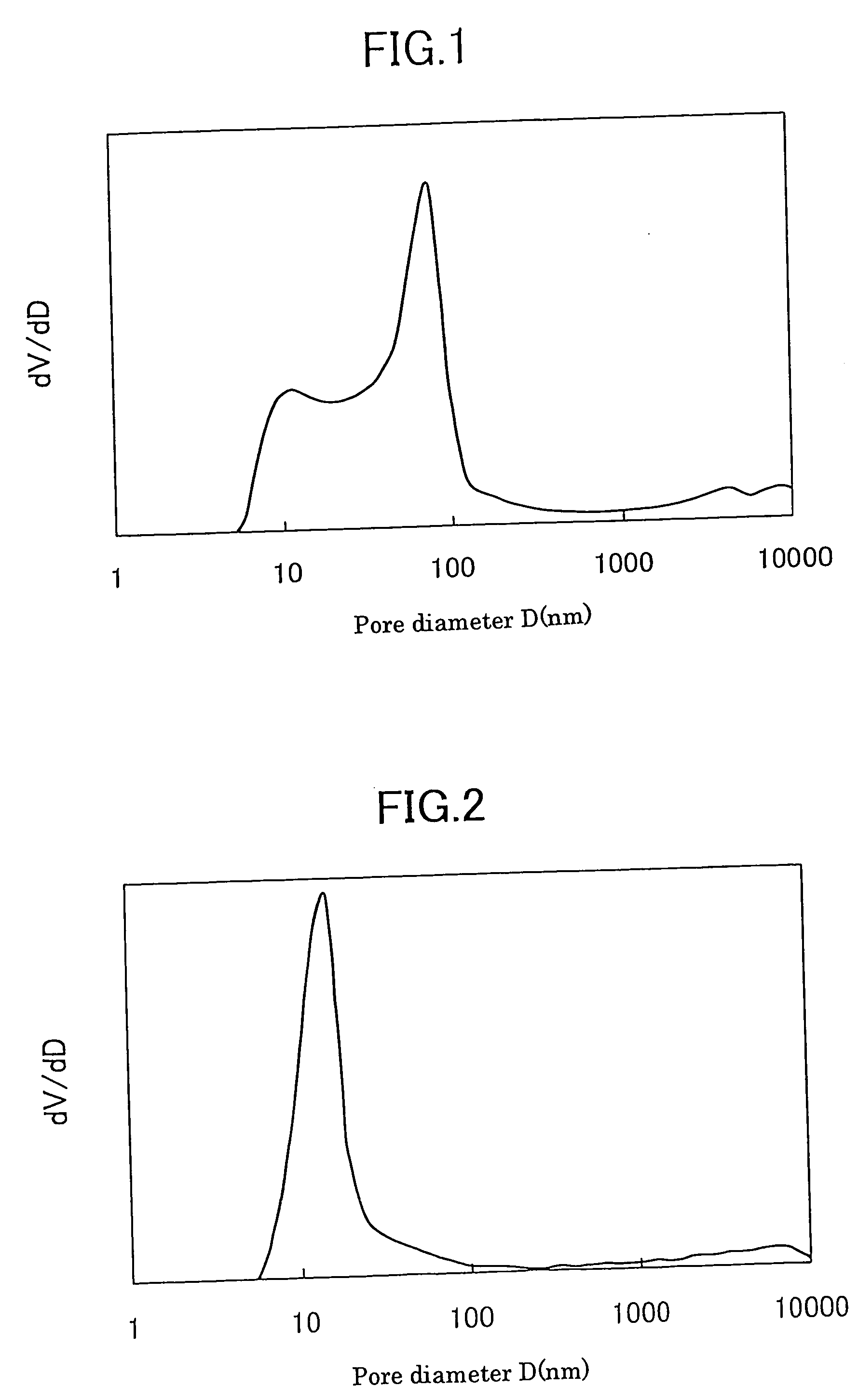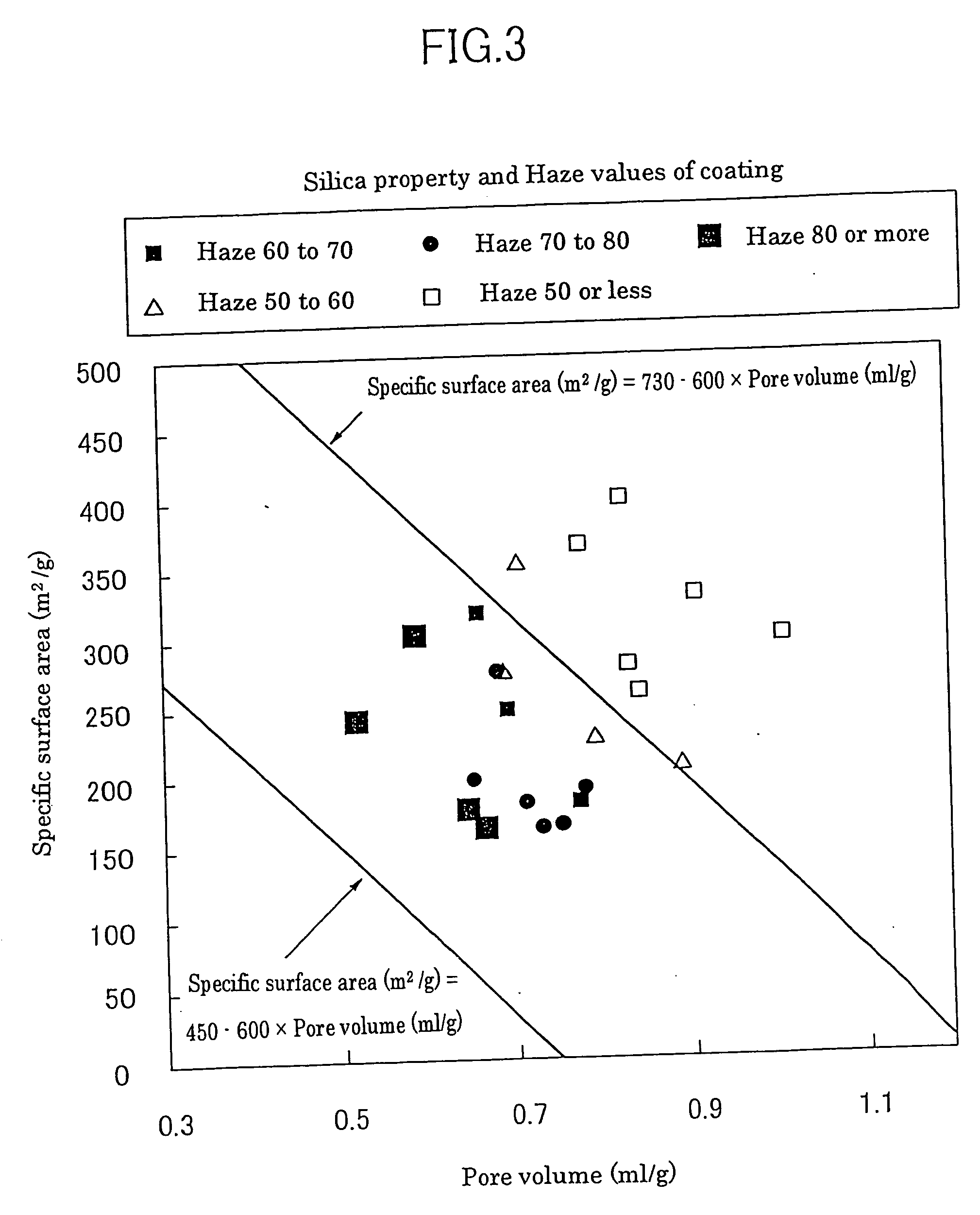Ink-jet recording sheets
- Summary
- Abstract
- Description
- Claims
- Application Information
AI Technical Summary
Benefits of technology
Problems solved by technology
Method used
Image
Examples
example 1
[0095] 0.5 part of 10% aqueous solution of sodium chloride and 40 parts of 10% aqueous solution of polyvinyl alcohol (produced by Kuraray Co., Ltd., trade name: PVA-140) of which the degree of saponification was 98.5% and that of polymerization was 4000 were mixed to 100 parts of fine particle silica dispersion liquid A to prepare a coating (paint) having 17.1% solid concentration wherein 0.25 part of sodium chloride and 20 parts of polyvinyl alcohol were contained to 100 parts of silica. Ion-exchange water was added thereto to make the concentration to 16.0%. The main component of the coating and pH were indicated in Table 1. The coating was bar-coated on the support so that the coating amount became 20 g / m2 in dry weight. Thus coated layer was dried at 120° C. to provide a porous ink absorbing layer.
[0096] Next, the coating liquid wherein 22 parts of the above 10% aqueous solution of polyvinyl alcohol of which the degree of saponification was 98.5% were mixed with 100 parts of ca...
example 2
[0112] 0.5 part of 10% aqueous solution of sodium sulfate and 40 parts of 10% aqueous solution of polyvinyl alcohol used in Example 1 were mixed to 100 parts of fine particle silica dispersion liquid A to prepare a coating having 17.1% solid concentration wherein 0.25 part of sodium sulfate and 20 parts of polyvinyl alcohol were contained to 100 parts of silica. The porous ink absorbing layer and the gloss layer were provided by the same method as that of Example 1 except for using 16.0% coating which was diluted by addition of ion-exchange water to produce the ink-jet recording sheet. The main component of the coating, pH and the method for laminating the gloss layer were indicated in Table 1. The pore distribution of the porous ink absorbing layer, cracking, surface pH and quality of the ink-jet recording sheet were shown in Table 2.
example 3
[0113] 1 part of 10% aqueous solution of sodium sulfate and 40 parts of 10% aqueous solution of polyvinyl alcohol (produced by Kuraray Co., Ltd., trade name: PVA-635) of which the degree of saponification was 95.0% and that of polymerization was 3500 were mixed to 100 parts of fine particle silica dispersion liquid A to prepare a coating having 17.1% solid concentration wherein 0.5 part of sodium sulfate and 20 parts of polyvinyl alcohol were contained to 100 parts of silica. The porous ink absorbing layer and the gloss layer were provided by the same method as that of Example 1 except for using 16.0% coating which was diluted by addition of ion-exchange water to produce the ink-jet recording sheet. The main component of the coating, pH and the method for laminating the gloss layer were indicated in Table 1. The pore distribution of the porous ink absorbing layer, cracking, surface pH and quality of the ink-jet recording sheet were shown in Table 2.
PUM
| Property | Measurement | Unit |
|---|---|---|
| Fraction | aaaaa | aaaaa |
| Pore size | aaaaa | aaaaa |
| Pore size | aaaaa | aaaaa |
Abstract
Description
Claims
Application Information
 Login to View More
Login to View More - R&D
- Intellectual Property
- Life Sciences
- Materials
- Tech Scout
- Unparalleled Data Quality
- Higher Quality Content
- 60% Fewer Hallucinations
Browse by: Latest US Patents, China's latest patents, Technical Efficacy Thesaurus, Application Domain, Technology Topic, Popular Technical Reports.
© 2025 PatSnap. All rights reserved.Legal|Privacy policy|Modern Slavery Act Transparency Statement|Sitemap|About US| Contact US: help@patsnap.com


